What are the paging methods in SQL server?
This article talks about the paging method of SQL server, using the SQL server 2012 version. In the following, pageIndex is used to represent the number of pages, and pageSize represents the records contained on one page. And the following involves specific examples, set the query page 2, each page contains 10 records.
First of all, let’s talk about the difference between SQL server’s paging and MySQL’s paging. MySQL’s paging can be completed directly by using limit (pageIndex-1) and pageSize. However, SQL server does not have the limit keyword, only something like limit. The top keyword. So paging is more troublesome.
There are only four types of SQL server paging that I know: triple loop; using max (primary key); using the row_number keyword, offset/fetch next keyword (summarized by collecting other people’s methods on the Internet , there should be only these four methods at present, other methods are based on this deformation).
Partial records of the student table to be queried

#Method 1: Triple loop
Idea
First take the first 20 page, then reverse order, and take the first 10 records in reverse order, so that you can get the data required for paging, but the order is reversed. You can then return it in reverse order, or you can stop sorting and hand it over directly to the front-end for sorting.
There is another method that can be considered to be of this type. I won’t put the code here. I will just talk about the idea, which is to first query the first 10 records, and then use not in to exclude these 10 records, and then Inquire.
Code implementation
-- 设置执行时间开始,用来查看性能的 set statistics time on ; -- 分页查询(通用型) select * from (select top pageSize * from (select top (pageIndex*pageSize) * from student order by sNo asc ) -- 其中里面这层,必须指定按照升序排序,省略的话,查询出的结果是错误的。 as temp_sum_student order by sNo desc ) temp_order order by sNo asc -- 分页查询第2页,每页有10条记录 select * from (select top 10 * from (select top 20 * from student order by sNo asc ) -- 其中里面这层,必须指定按照升序排序,省略的话,查询出的结果是错误的。 as temp_sum_student order by sNo desc ) temp_order order by sNo asc ;
Query results and time
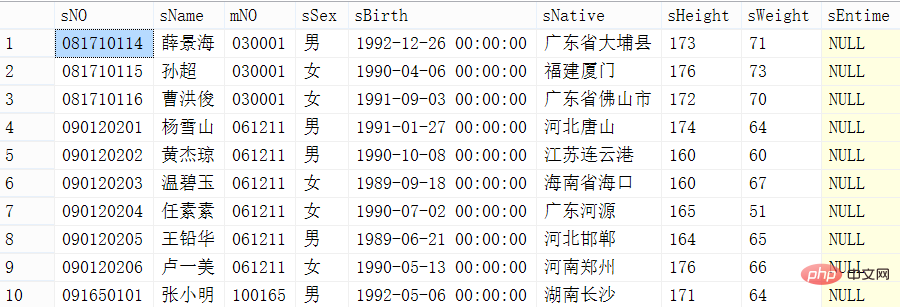
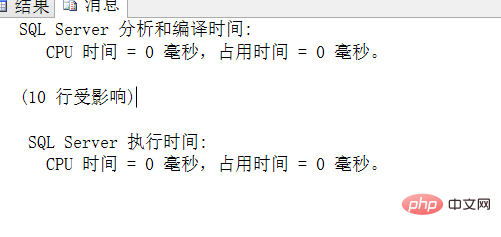
Method 2: Use max (Primary key)
First, top the first 11 row records, then use max (id) to get the largest id, and then re-query the first 10 records in this table, but you must add conditions, where id>max( id).
Code implementation
set statistics time on; -- 分页查询(通用型) select top pageSize * from student where sNo>= (select max(sNo) from (select top ((pageIndex-1)*pageSize+1) sNo from student order by sNo asc) temp_max_ids) order by sNo; -- 分页查询第2页,每页有10条记录 select top 10 * from student where sNo>= (select max(sNo) from (select top 11 sNo from student order by sNo asc) temp_max_ids) order by sNo;
Query results and time
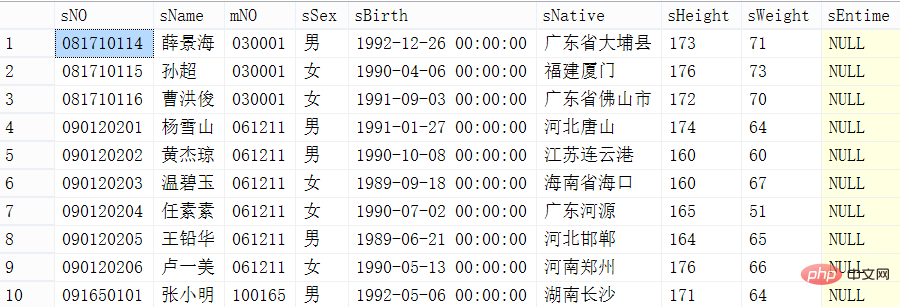

set statistics time on;
-- 分页查询(通用型)
select top pageSize *
from (select row_number()
over(order by sno asc) as rownumber,*
from student) temp_row
where rownumber>((pageIndex-1)*pageSize);
set statistics time on;
-- 分页查询第2页,每页有10条记录
select top 10 *
from (select row_number()
over(order by sno asc) as rownumber,*
from student) temp_row
where rownumber>10;
Copy after login
Query results and time
set statistics time on; -- 分页查询(通用型) select top pageSize * from (select row_number() over(order by sno asc) as rownumber,* from student) temp_row where rownumber>((pageIndex-1)*pageSize); set statistics time on; -- 分页查询第2页,每页有10条记录 select top 10 * from (select row_number() over(order by sno asc) as rownumber,* from student) temp_row where rownumber>10;
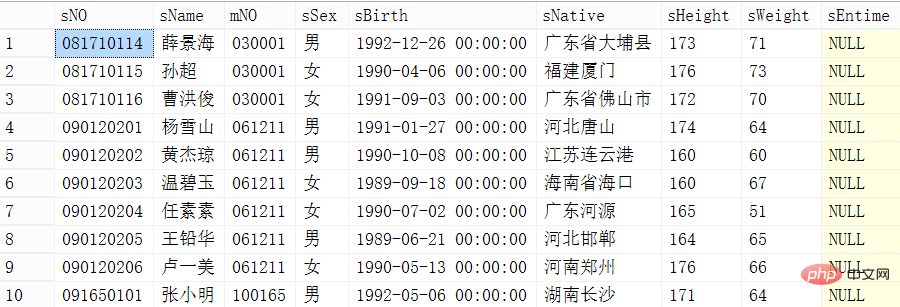
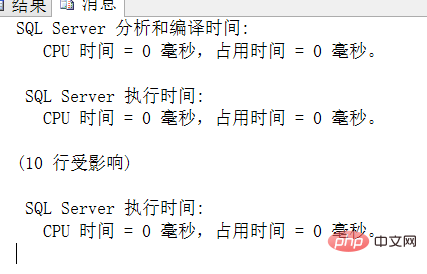
set statistics time on;
-- 分页查询(通用型)
select * from student
order by sno
offset ((@pageIndex-1)*@pageSize) rows
fetch next @pageSize rows only;
-- 分页查询第2页,每页有10条记录
select * from student
order by sno
offset 10 rows
fetch next 10 rows only ;
Copy after login
offset A rows, discard the first A record, fetch next B rows only, read backward B data. Results and running time
set statistics time on; -- 分页查询(通用型) select * from student order by sno offset ((@pageIndex-1)*@pageSize) rows fetch next @pageSize rows only; -- 分页查询第2页,每页有10条记录 select * from student order by sno offset 10 rows fetch next 10 rows only ;
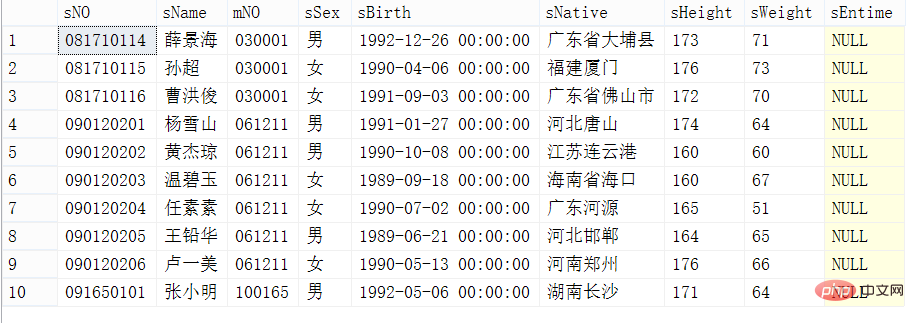
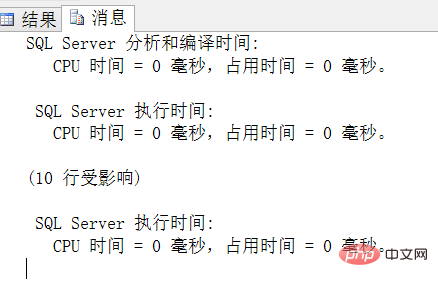
create procedure paging_procedure ( @pageIndex int, -- 第几页 @pageSize int -- 每页包含的记录数 ) as begin select top (select @pageSize) * -- 这里注意一下,不能直接把变量放在这里,要用select from (select row_number() over(order by sno) as rownumber,* from student) temp_row where rownumber>(@pageIndex-1)*@pageSize; end -- 到时候直接调用就可以了,执行如下的语句进行调用分页的存储过程 exec paging_procedure @pageIndex=2,@pageSize=10;
mysql tutorial"
The above is the detailed content of What are the paging methods in SQL server?. For more information, please follow other related articles on the PHP Chinese website!

Hot AI Tools

Undresser.AI Undress
AI-powered app for creating realistic nude photos

AI Clothes Remover
Online AI tool for removing clothes from photos.

Undress AI Tool
Undress images for free

Clothoff.io
AI clothes remover

AI Hentai Generator
Generate AI Hentai for free.

Hot Article

Hot Tools

Notepad++7.3.1
Easy-to-use and free code editor

SublimeText3 Chinese version
Chinese version, very easy to use

Zend Studio 13.0.1
Powerful PHP integrated development environment

Dreamweaver CS6
Visual web development tools

SublimeText3 Mac version
God-level code editing software (SublimeText3)

Hot Topics
 1378
1378
 52
52
 How do I comply with data privacy regulations (GDPR, CCPA) using SQL?
Mar 18, 2025 am 11:22 AM
How do I comply with data privacy regulations (GDPR, CCPA) using SQL?
Mar 18, 2025 am 11:22 AM
Article discusses using SQL for GDPR and CCPA compliance, focusing on data anonymization, access requests, and automatic deletion of outdated data.(159 characters)
 How do I secure my SQL database against common vulnerabilities like SQL injection?
Mar 18, 2025 am 11:18 AM
How do I secure my SQL database against common vulnerabilities like SQL injection?
Mar 18, 2025 am 11:18 AM
The article discusses securing SQL databases against vulnerabilities like SQL injection, emphasizing prepared statements, input validation, and regular updates.
 How do I implement data partitioning in SQL for performance and scalability?
Mar 18, 2025 am 11:14 AM
How do I implement data partitioning in SQL for performance and scalability?
Mar 18, 2025 am 11:14 AM
Article discusses implementing data partitioning in SQL for better performance and scalability, detailing methods, best practices, and monitoring tools.
 How to use sql datetime
Apr 09, 2025 pm 06:09 PM
How to use sql datetime
Apr 09, 2025 pm 06:09 PM
The DATETIME data type is used to store high-precision date and time information, ranging from 0001-01-01 00:00:00 to 9999-12-31 23:59:59.99999999, and the syntax is DATETIME(precision), where precision specifies the accuracy after the decimal point (0-7), and the default is 3. It supports sorting, calculation, and time zone conversion functions, but needs to be aware of potential issues when converting precision, range and time zones.
 How do I use SQL for data warehousing and business intelligence?
Mar 18, 2025 am 11:16 AM
How do I use SQL for data warehousing and business intelligence?
Mar 18, 2025 am 11:16 AM
The article discusses using SQL for data warehousing and business intelligence, focusing on ETL processes, data modeling, and query optimization. It also covers BI report creation and tool integration.
 How to use sql if statement
Apr 09, 2025 pm 06:12 PM
How to use sql if statement
Apr 09, 2025 pm 06:12 PM
SQL IF statements are used to conditionally execute SQL statements, with the syntax as: IF (condition) THEN {statement} ELSE {statement} END IF;. The condition can be any valid SQL expression, and if the condition is true, execute the THEN clause; if the condition is false, execute the ELSE clause. IF statements can be nested, allowing for more complex conditional checks.
 How to create tables with sql server using sql statement
Apr 09, 2025 pm 03:48 PM
How to create tables with sql server using sql statement
Apr 09, 2025 pm 03:48 PM
How to create tables using SQL statements in SQL Server: Open SQL Server Management Studio and connect to the database server. Select the database to create the table. Enter the CREATE TABLE statement to specify the table name, column name, data type, and constraints. Click the Execute button to create the table.
 How to avoid sql injection
Apr 09, 2025 pm 05:00 PM
How to avoid sql injection
Apr 09, 2025 pm 05:00 PM
To avoid SQL injection attacks, you can take the following steps: Use parameterized queries to prevent malicious code injection. Escape special characters to avoid them breaking SQL query syntax. Verify user input against the whitelist for security. Implement input verification to check the format of user input. Use the security framework to simplify the implementation of protection measures. Keep software and databases updated to patch security vulnerabilities. Restrict database access to protect sensitive data. Encrypt sensitive data to prevent unauthorized access. Regularly scan and monitor to detect security vulnerabilities and abnormal activity.




